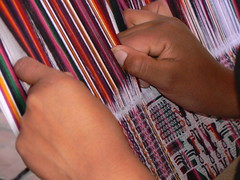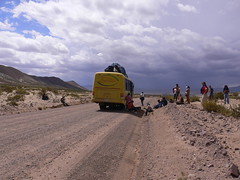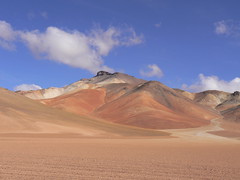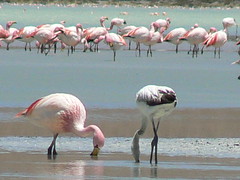(Continued from day 3)
5 o’clock in the morning we got up, to see the sun rise at the geysers named ‘Sol de Mañana’. Without knowing what to expect, we were quite surprised that we arrived at a landscape equal to Mars (again!). This time it was even more unearthly
than at the volcano Tunupa, with numerous geysers shooting high-pressure jet of steam out from the earth, surrounded by countless boiling pools of mud and sulphur in several colours intensified by the beauty of the sun rise. The only downside was the intense smell of rotten eggs, caused by the sulphur coming from the underground… :-)
Continuing south towards the Chilean border in almost 5000 meters above sea level we passed a desert landscape with colourful volcanoes and some spectacular rock formations half covered in volcano dust called the “Dali rocks” inspired by one of Salvador Dali’s paintings.
The last scheduled stop before the Chilean border was at the volcano Licancabur and Laguna Verde (The green lake). This volcano marks the border between Chile and Bolivia, and has been used as playground for NASA’s Mars-vehicles… (This was our last meeting with Mars on the trip).
At the foot of the volcano lays the green lake, which has a deep green colour from the algae in the water.
At the Chilean border we parted with the Swede, without tears…because it left more space in the jeep for our 390 km. journey back to Uyuni - on dirt road.
Having expected just a long boring ride back to Uyuni, we were positively surprised by the encounter of a Bolivian ostrich the ‘Ñandú’ who must have inspired the Road Runner cartoon, from the dust stirred up behind it as it galloped away from the car “BEEP, BEEP!”
We also encountered the Bolivian hare ‘Vizcacha’ jumping acrobatically in another bunch of gigantic lava rocks, where only the imagination could set limits for the variety of animals and figures that the rocks formed. We saw both a lion eating its prey and a huge pelican guarding the place…besides the livelier vizcacha.
The driver thought we had time for another extra, so he squeezed in a stop at the deep ‘Cañon de Cascadas’ ( Canyon of the waterfalls). It looked most of all like one of Gaudis creations combined with the imagination of Mother Nature with the twisting and sparkling river in the bottom of the canyon.
The last (unscheduled) stop was in San Cristobàl which is a 5 year old indigenous village which has been constructed by a mining company that forced all the inhabitants to move from their original town at the newly discovered mining site. It seems quite brutal to force a whole community to move from the home, but after 5 years the mining company and the authorities are still doing a lot to help the locals by improving the infrastructure and by promoting tourism in the area, so maybe it will work out for the locals benefit.
Arriving back in Uyuni tired, after no good sleep in four days dirty, after four days with only one shower and loads of dusty dirt roads, we had the feeling that Bolivia must be the place on earth that demonstrates the most spectacular nature within such a small area. Definitely one of our best experiences so far here in South America.
And a nice side effect: We learned that we actually know Spanish by now. After having acted as Spanish-English interpreters for four days, we feel confident in the language… Sometimes it is under those circumstances that you become conscious of you limits and abilities.
(The end.)





